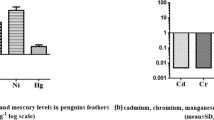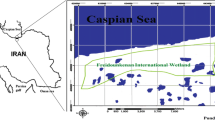Abstract
Arsenic, cadmium, chromium, lead, manganese, mercury, selemium,and tin concentrations were measured in the feathers of Capecormorant (Phalacrocorax capensis), Hartlaub’s gull(Larus hartlaubii), kelp gull (Larus dominicanus), andlesser flamingo (Phoeniconaias minor) from the coast ofNamibia in southern Africa. Metal concentrations in feathers represent the concentrations in the blood supply at the time offeather formation. Cape Cormorants are piscivores; kelp gullsare primarily piscivores; Hartlaub’s gull is an omnivore; and lesser flamingos eat primarily blue-green algae and invertebrates filtered from the water and sediment ofhypersaline lagoons. We predicted that metal concentrationswould reflect these trophic level differences. There weresignificant species differences in the concentrations of allmetals, with flamingos having the lowest levels, and cormorantshaving the highest levels of 4 metals but not mercury. The gulls hadthe highest levels of mercury, perhaps reflecting their morescavenging behavior.
Similar content being viewed by others
References
Applequist, H., Asbirk, S. and Drabeck, I.: 1984, ‘Mercury monitoring: mercury stability in bird feathers’. Mar. Pollut. Bull. 15, 22–24.
Australian Government:1980, ‘Mercury in fish and fish products’, Australian Government Publ Service, Canberra, Australia.
Berry, H. H.: 1976, ‘Physiological and behavioral ecology of the Cape cormorant Phalacrocorac capensis’,Madoque 9, 5–55.
Berry, H. H.: 1977, ‘Seasonal fidelity of cape cormorants to nesting area’, Cormorant 2, 5–6.
Blankley, W. O.: 1981, ‘Marine food of kelp gulls, lesser sheathbills, and imperial cormorant at marion Island (Subantarctic)’, Cormorant 9, 77–84.
Braune, B. M. and Gaskin, D. E.: 1987, ‘A mercury budget for the Bonaparte’s gull during autumn moult’, Ornis Scan 18, 244–250.
Brook, R. K. and Cooper, J.: 1979, ‘What is the feeding niche of the kelp gull in South Africa?’, Cormorant 7, 27–29.
Brown, L. H., Urban, E. K. and Newman, K.: 1982, ‘The birds of Africa, Vol. 1’, Academic Press, New York.
Bull, K. R., Murton, R. K., Orborn, D. and Ward, P.: 1977, ‘High levels of cadmium in Atlantic seabirds and sea-skaters’, Nature 269, 507–509.
Bull, K. R., Dearsley, A. F. and Inskip, M. H.: 1981, ‘Growth and mercury content of roach (Rutilus rutilus L.), perch (Perca fluviatilis L.) and pike (Esox lucius L.) living in sewage effluent’, Envir. Pollut. 26, 229–240.
Burger, J.: 1993, ‘Metals in avian feathers: bioindicators of environmental pollution’, Rev. Envir. Tox. 5, 301–311.
Burger, J. and Gochfeld, M.: 1991, ‘Lead, mercury, and cadmium in feathers from tropical terns in Puerto Rico and Australia’, Archiv. Envir. Contam. Tox. 21, 311–315.
Burger, J, and Gochfeld, M.: 1999a, ‘Interspecific and locational differences in heavy metal levels in four species of birds near Sydney, Australia’, Envir. Monit. Assess. 58, 105–119.
Burger, J. and Gochfeld, M.: 1999b, ‘Metals in Laysan albatrosses from Midway Atoll’, Environ. Res. (in press).
Burger, J. and Trevedi, C. D. and Gochfeld, M.: 1999, ‘Metals in herring and great blackbacked gulls from the New York Bight: the role of salt in excretion’, Envir. Monit. Assess. (in press).
Burger, J., Veitch, C. R. and Gochfeld, M.: 1994, ‘Locational differences in metal concentrations of feathers of Australasian gannet (Morus serrator) in New Zealand’, Envir. Monit. Assess. 32, 47–57.
Burger, J., Cooper, J., Saliva, J., Gochfeld, D., Lipsky, D. and Gochfeld, M.: 1992, ‘Mercury bioaccumulation in organisms from three Puerto Rican estuaries’, Envir. Monit. Assess. 22, 181–187.
Duffy, D. C., Wilson, R. P. and Wilson, M. P.: 1987, ‘Spatial and temporal patterns in diet in the Cape cormorant off southern Africa’, Condor 89, 830–834.
Fitzgerald, W. F. and Mason, R. P.: 1996, ‘The global mercury cycle: oceanic and anthropogenic aspects’, pp 85–108 in Global and regional mercury cycles: sources, fluxes and mass balances (Baeyens W, Vasiliev O, Ebinghaus R), (eds). Kluwer Acad. Publ. Netherlands.
Fitzgerals, W. F., Engstrom, D. R., Mason, R. P. and Nater, E. A.: 1998, ‘The case for atmospheric mercury contamination in remote areas’, Envir. Sci. Tech. 32, 1.
Furness, R. W.: 1982, ‘Modelling relationships among fisheries, seabirds, and marine mammals’, pp 116–126 in marine birds: their feeding ecology and commercial fisheries relationships (Nettleship DN, Sanger GA, Springer Pf), (eds.). Special Publ. Canadian Wildl Ser. Dartmouth, Nova Scotia.
Furness, R. W. and Cooper, J.: 1982, ‘Interactions between breeding seabirds and pelagic fish populations in the southern Benguela region’, Mar. Ecol. 8, 243–250.
Furness, R.W., Muirhead, S. J. and Woodburn, M.: 1986, ‘Using bird feathers to measure mercury in the environment: relationships between mercuty content and moult’, Mar. Poll. Bull. 17, 27–30.
Furness, R. W., Lweis, S. A. and Mills, J. A.: 1990, ‘Mercury levels in thenplumage of red-billed gull (Larus novaehollandiae scopulinis) of known sex and age’, Envir. Pollut. 63, 33–39.
Hahn, E., Hahn, K. and Stoeppler, M.: 1993, ‘Bird feathers as bioindicators in areas of the German Environmental Specimen Bank – bioaccumulation of mercury in food chains and exogenous deposition of atmospheric pollution with lead and cadmium’, Sci. Total Envir. 139, 259–270.
Harrison, J. A., Allan, D. G., Underhill, L. G., Herremans, M. Tree, A. J., Parker, V., and Brown, C. J.: 1997, ‘The atlas of Southern African birds. Birdlife, South Africa. Johannesburg, South Africa.
Honda, K., Marcovecchio, J. E., Kan, S., Tatsukawa, R. and Ogi, H.: 1990, ‘Metal concentrations in pelagic seabirds from the north Pacific Ocean’, Arch. Envir. Contam. Toxicol. 19, 704–711.
Hunter, R. A. and Johnson, J. G.: 1982, ‘Food chain relationship of copper and cadmium in contaminated grassland ecosystems’, Oikos 38, 108–117.
Lock, J. W., Thompson, D. R., Furness, R. W. and Bartle, J. A.: 1992, ‘Metal concentration in seabirds of the New Zealand region’, Envir. Poll. 75, 289–300.
Maedgen, J. L., Hacker, C. S., Schroder, G. D. and Weir, F.: 1992, ‘Bioaccumulation of lead and cadmium in the royal tern and sandwich tern’, Arch. Envir. Contam. Toxicol. 11, 99–102.
Ridley, M. W., Moss, B. L., Percy, R. C.: 1955, ‘The food of flamingoes in Kenya colony’, J. E. Afr. Nat. Hist. Soc. 22, 147–158.
SAS (Statistical Analysis Systems) (1995) SAS Users’ Guide, Statistical Analysis Institute, Cary, NC.
Shaughnessy, P. D.: 1980, ‘Food of kelp gulls Larus dominicanus at square point, SouthWest Africa’, Cormorant 2, 99–100.
Silbernagl, P.: 1979, ‘Hartlaub’s gulls feeding on earthworms’, Cormorant 6, 40.
Simon, D.: 1977, ‘Hartlaub’s gulls feeding at night on insects’, Cormorant 3, 17.
Steel, W. K.: 1992, ‘Breeding of Hartlaub’s gull Larus hartlaubii at Hout Bay Harbour, South Afrika’, Mar. Ornithol. 20, 75–79.
Thompson, D. R. and Furness, R. W.: 1989, ‘Comparison of the levels of total and organic mercury in seabird feathers’, Mar. Pollut. Bull. 20, 577–579.
Urban, E. K., Fry, C. H. and Keith, S.: 1986, ‘The birds of Africa, vol 2’, Academic Press, New York.
van Straalen, N. M. and Ernst, E.: 1991, ‘Metal biomagnification may endanger species in critical pathways’, Oikos 62, 255–256.
Vareschi, E.: 1978, ‘The ecology of Lake Nakuru, 1. abundance and feeding of the lesser flamingo’, Oecol. Bull. 32, 11–35.
Walsh, P. M.: 1990, ‘The use of seabirds as monitors of heavy metals in the marine environment’, pp. 183–294. In Heavy metals in the marine environment (Furness RW, Rainbow PS), (eds.). CRC Press, Boca Raton FL.
Walter, C. B.: 1984, ‘Fish prey remains in swift tern and Hartlaub’s gull pellets at Possession Island, off Namibia’, Ostrich 55, 166–167
Williams, A. J. and Burger, A. E.: 1978, ‘The ecology of the prey of cape and bank cormorants;, Cormorant 4, 28–29.
Wilson, R. P. and Wilson, M. P.: 1988, ‘Foraging behaviour in four sympatric cormorants’, J. Appl. Ecol. 57, 943–955.
Wright, J. W. (ed.).: 1999, ‘The New York Almanac for 1999’, New York Times Inc., New York.
Author information
Authors and Affiliations
Corresponding author
Rights and permissions
About this article
Cite this article
Burger, J., Gochfeld, M. Metal Levels in Feathers of Cormorants, Flamingos and Gulls from the Coast of Namibia in Southern Africa. Environ Monit Assess 69, 195–203 (2001). https://doi.org/10.1023/A:1010710108434
Issue Date:
DOI: https://doi.org/10.1023/A:1010710108434




